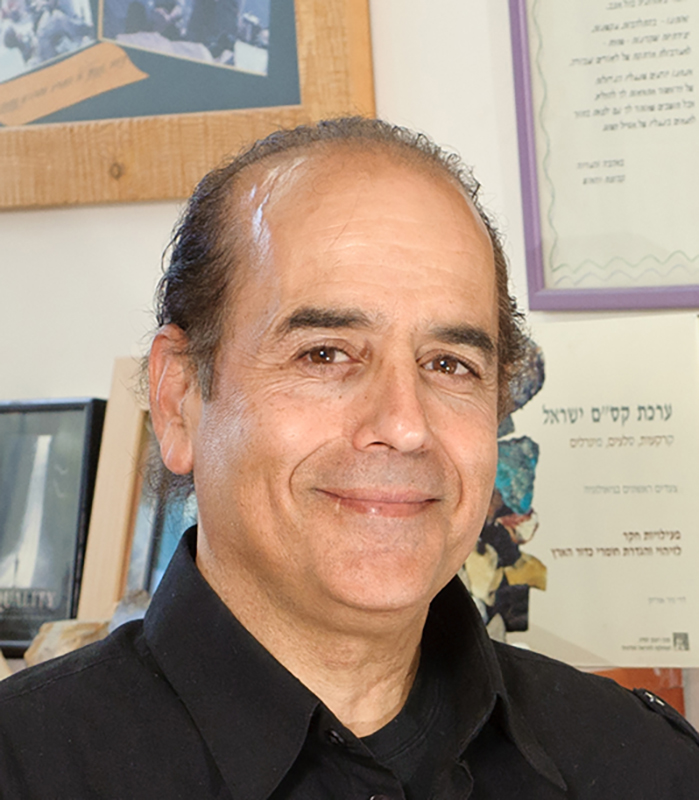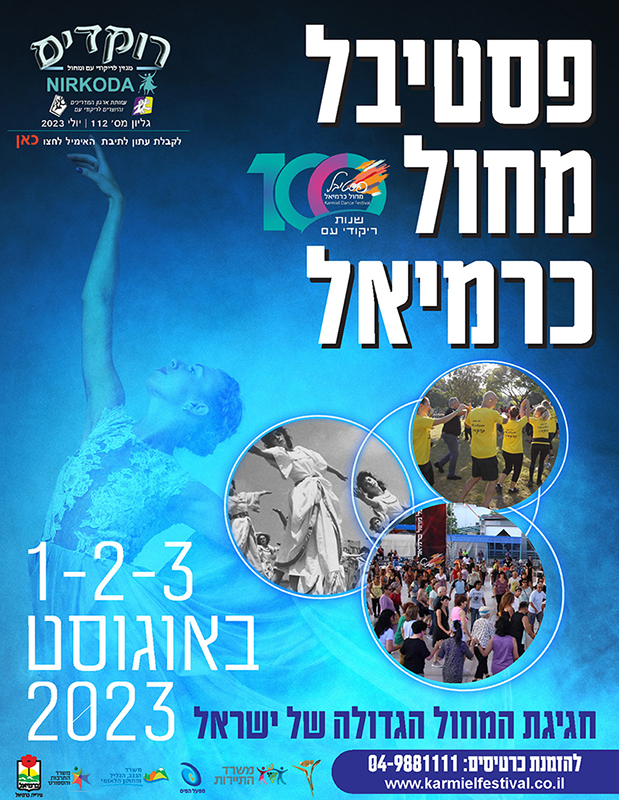- Home
- Rokdim Nirkoda 112
- Fallow the Fallow (Shmitat Shmitut)
Fallow the Fallow (Shmitat Shmitut)
The “Everything is Danceable” Revolution - Dances of the People
Introduction
Yaron Meishar’s article “We Need A ‘Fallow Year’ (Shnat Shmita)” published in Rokdim-Nirkoda issue #111 represents many veteran dancers who are dissatisfied with the quantity and quality of the dances being taught in classes today and long for those “good old days” of folk dancing.
Yaron suggests a fallow year – a gap year of not teaching new dances. He claims that the new dances, which he calls “recreational dances” and “temporal dances”, harm the quality of instruction, the quality of performance as well as the enjoyment and satisfaction of the dance as movement together. The article presents an apocalyptic vision of the folk dance movement. He compares the current situation to a frog enjoying the hot water in a pot in the first stages of cooking, without foreseeing the continuation of the process.
It’s impossible to argue with emotions and feelings. At the same time, other points of view must be reflected, and this is what I intend to do.
Full disclosure: I started folk dancing when I was in my 50s, about 17 years ago. So, whatever is written below is based on my limited experience and represents a narrow point of view in terms of the breadth and depth of the phenomenon.
It used to be happy here before I was born
I grew up in the Borochov neighborhood in Givatayim and was exposed to folk dances as early as my time in elementary school and especially as a teenager in the Tnuat HaNoar HaOved Ve’Halomed – Working and Learning Youth Movement. My older sister was part of Yoav Ashriel’s dance troupe, which was a source of family pride. The youth movement had a dance instructor who came once a week, initially accompanied by an accordionist and then he was replaced in favor of a reel-to-reel tape player the size of a refrigerator.
The process of learning a new dance was endless. I remember a few dances from that time: Circle dances included “Kuma Echa”, “Nitzanim Nir’u Ba’Aretz”, “Mizareh Yisrael”, “Al Tira”, and the biggest hit, “HaRo’ah HaK’tana”; couple dances included “Bat Yiftach”, but mostly I remember the adapted international couple dances such as “Mazurka” and “Korobushka”.
It’s possible that the dances mentioned above are part of a group defined by Yaron as “real” folk dances, but he doesn’t detail the criteria for sorting the dances.
In my perception, folk dances are – as titled – dances of the people. And “a people” is a dynamic concept. The people of the 1940s and the 1950s are not the same as today. But for those of us born at the end of the 1960s and the beginning of the 1970s, I can tell you that at that time, even in the youth movements, there was no great joy from folk dancing. The “Hora” dances that were the “the rage” of the ‘40s – ‘50s generation were no longer appealing to the younger generation of the ‘60s and ‘70s. Folk dance was perceived by my generation as archaic.
According to Meishar, “the magic of folk dances, the enjoyment, the satisfaction, comes from moving together”.
There is no doubt that the “together” experience was a cornerstone of the folk dance movement. The founding generation, and especially the kibbutz movement, sanctified “togetherness” and unity. However, what suited them does not necessarily suit others.
For instance, my “togetherness” experience from folk dancing is traumatic. I’m speaking of the obsessive demand to “hold hands”. Touching sweaty hands caused me great physical discomfort. This is one of the reasons why I didn’t feel at all bad when one of the instructors stopped coming to the sessions because of the small number of participants.
I am not a folk dance researcher. But from my limited experience of about 15 years (4-6 days a week with about 10 different instructors and classes), I don’t find any basis for the claim that the enjoyment and satisfaction of dancing comes from moving together. The way I see it, the satisfaction of most of the dancers comes from the movement itself, and not necessarily from the uniform movement of all the dancers. From my personal experience, enjoyment comes from the movement, and the satisfaction stems primarily from the ability to perform the steps correctly.
Dancing as part of a group is very important, but there should be a distinction between “social togetherness” and “movement togetherness”.
The collective and social “togetherness” of the first years after the establishment of the State of Israel is no longer, not even in the kibbutzim.
The “Everything is Danceable” Revolution – Dances of the People (Folk Dance)
About 30 years have passed since I stopped folk dancing in the 1970s, until I finally gave in to my wife’s pleas to come dance with her. The encounter was very surprising. The folk dances I saw were totally different from the ones I knew. I saw a wide range of music and rhythms, from waltz to salsa, from the Gevatron to Dudu Aharon – the “everything is danceable” revolution.
Besides the change in the type of music, the demographic change of the dancers also stood out. The “everything is danceable” revolution completely changed the demographic balance of folk dances. I am not a sociologist or an anthropologist, but it seems to me that it wouldn’t be unreasonable to assume that the “everything is danceable” revolution and the demographic change within the folk dance movement are the consequences of the late 1970s political upheaval, which led to a cultural revolution in Israeli songs and folk dances.
I wasn’t there when the folk dance movement of the past met contemporary Israeli music in all its nuances. But the reverberations of this meeting are still felt today. From conversations with veteran dancers, it appears that for some of them, it was a traumatic encounter; the pain of loss and longing is evident in them to this day. This pain carries within it the longing for another society, a different culture, and for a lost youth.
I understand the pain, but since I wasn’t part of the earlier folk dance experience, my perspective is different.
Yaron Meishar compares the folk dance situation of today to “a frog being cooked in a pot”. In my opinion, the “everything is danceable” revolution revived that frog that was in danger of extinction. It saved the folk dance movement from becoming fossilized. Suiting folk dances to contemporary music while preserving folk dances of the past as inalienable assets has turned Israeli folk dancing into a timeless phenomenon.
Quality vs. Quantity – Dances and Instructors
The central claim of the “Fallow Year” article is that the quantity of new dances flooding the dance sessions is harming the quality and the essence of folk dancing and will lead to its disintegration.
I don’t agree with this claim and I’m sure I’m not the only one. Learning a new dance is a challenge for me, accompanied by enjoyment and satisfaction. At the same time, as a collector of dances, I’m very choosy and am not lured by every dance. For me, a good dance includes the “holy trinity” of melody, lyrics, and movement. If one of the three isn’t to my taste, I sit it out. Unfortunately, it often happens that I sit out a number of dances in a row, one after the other.
It’s depressing, but that’s the price you pay for a multi-cultural society. I purposely emphasized “not to my taste”. I have long understood that my taste doesn’t always suit the taste of others. For every dance that doesn’t suit me, there are many who dance it with great joy. At the same time, if a particular dance group has a tendency toward a specific style that doesn’t suit individual dancers, they find another group to dance with.
I have heard the claim that the folk dance community is decreasing since I started dancing 15 years ago. In reality, at least in the Nes Ziona region where I live, the number of dance sessions is increasing. On any given day 3-5 sessions are open within a 15-kilometer radius. The groups can be characterized by age, ratio of circle to couple dances, “middle of the road” (widely-known) to special dances, of quiet and lyrical to rhythmic and upbeat, repertory to eclectic dances, number of new dances taught; size of the group (hundreds / dozens of participants); quality of the teaching. In addition, there are groups just for beginners as well as groups just for women.
Therefore, I see no reason for a “fallow year” of new dances. The variety of instructors and the variety of groups create the necessary balance between the variety of what the dancers want and the variety of dances.
An additional claim raised in the article concerns the quality of instruction, and that the proliferation of new dances lowers the teaching quality and style. Teaching a new dance today is not as sufficiently thorough.
From my own personal experience, I don’t see the correlation. There are excellent veteran instructors and some who are less so. And there are also excellent young instructors and some who are less so.
Moreover, the claim that teaching only “old” dances will influence the quality of instruction is invalid, as most dancers today will take them as new dances.
In conclusion, today’s folk dance movement does not need regulation or guidance from above – or from any other place. The wide social diversity of the dancers and of the groups creates a process of natural selection. What determines the quality of a dance is its ability to cross the dimension of time.
At the time of the establishment of the State of Israel, the theme of the homogenous folk dance community was “togetherness” and the shared identity. The main theme in contemporary folk dance is diversity. With the background of a divided and polarized nation, the phenomenon of Israeli folk dance is unique. This is perhaps the only activity in Israel where positive interaction will be found across the cultural spectrum, the beliefs and opinions which characterize the people – left, right, secular, religious, atheist, ultra-Orthodox, Sephardim, Ashkenazim – all under one roof.
If “holding hands” was a sacred value of folk dancing at the founding of the State, the value that should be sacred today is respect for diversity, inclusion, and the deferral of gratification.









Comments
התראות